
The list of great surfing spots in Spain. Weather features and best time to travel
Spain is undoubtedly one of the best countries in the world to practice surfing, and it is certainly the best in Europe. There is a good swell most of the year, including swell period, wave height, and energy. What else do you need to do this kind of sport?
In this post, we have compiled all the best surfing spots in Spain, including the Bay of Biscay in the north of the country and the Mediterranean Sea coast, where you can practice your favorite sport or try it for the first time. Each text includes a brief description, the main characteristics of the local weather in the four seasons, and the best time to go.
Follow the link at the end of each spot to find the most accurate wave and wind forecast for it and other weather parameters for the next 10 days. Even more detailed and useful weather information is available on the spot pages.
San Sebastian
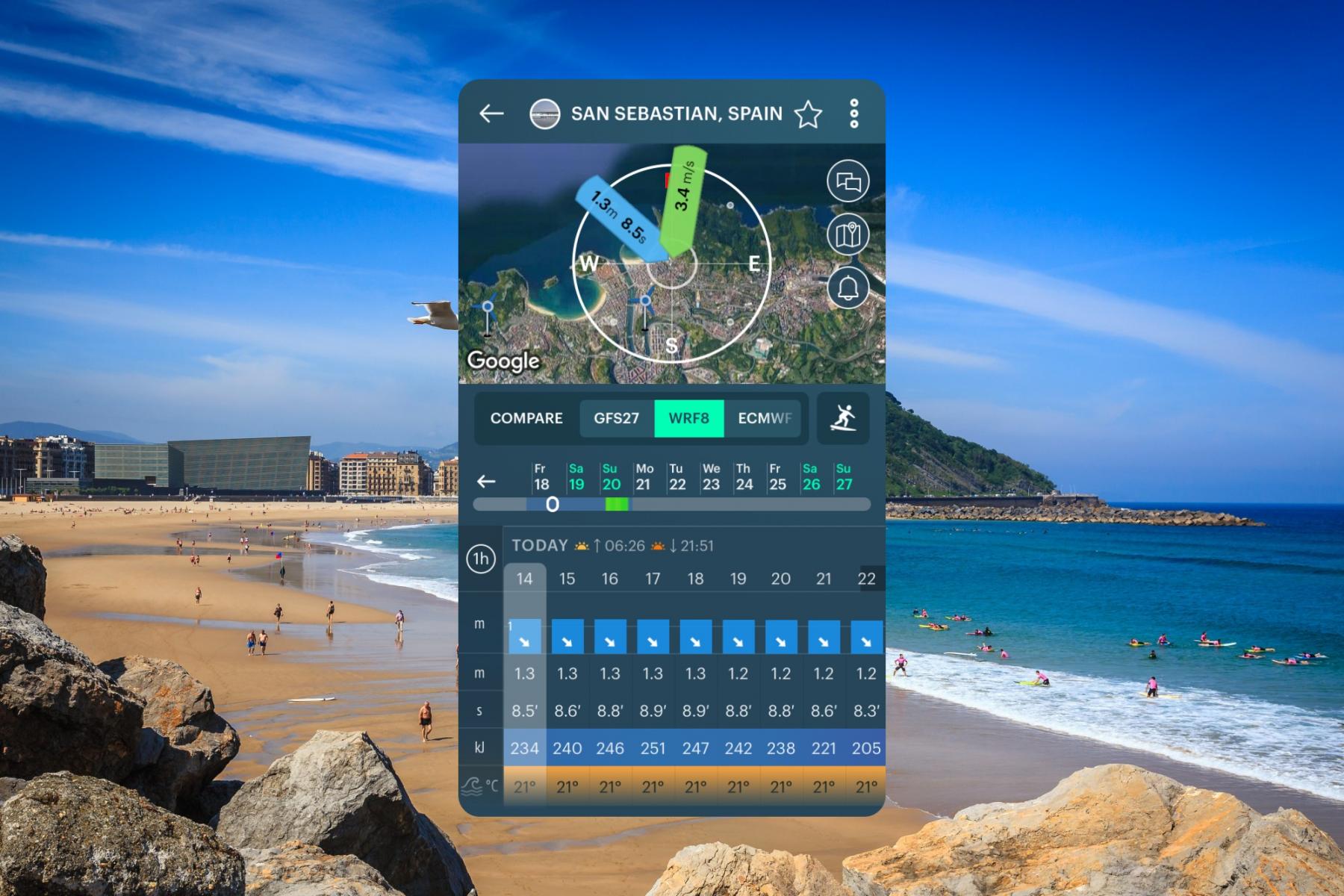
Weather forecast for San Sebastian for kitesurfing, windsurfing and surfing in Spain in the Windy.app for iOS
An overview
San Sebastian and the whole Basque Country offer the conditions that every surfer wants to find, good wind, waves, and incredible beaches. The different beaches offer options for all levels of expertise. The three main beaches for surfers are Ondarreta, La Concha, and Zurriola.
La Concha is characterized by high tide, the waves have a peak at each end of the beach.
Ondarreta’s main characteristic is its “wall” wave. At high tide, the waves crash against the seawall and generate rebounds that give rise to powerful and hollow waves. These are options that need high tide and are perfect when the rest of the beaches are full of bathers.
Zurriola on the other hand is known for medium or low tides, has a powerful peak that opens right and left for the more experienced but in the middle comes out a long and powerful left perfect for beginners.
The main weather features
The weather in San Sebastian also known as Donostia is defined as subpolar oceanic with few temperature oscillations, it is characterized by being rainy all year round, even in summer months, it also has abundant rainfall, with a 1470 mm annual average. Humidity is always above 75%.
- Winter. The perfect time of year for surfers. Despite the cold water at 11 degrees, in winter there are excellent waves here
- Spring. In the spring, there are few people, the water is warm enough and good medium-sized waves arise
- Summer. For professionals, this is not the best time because of the small waves and the strong overcrowding of the beaches
- Autumn. A great period for trained surfers as huge good waves are rising
Best time to travel
The best time to visit San Sebastian if it’s for surfing will depend on your level of experience and the style you want to practice. It is a windy city but the windiest part of the year goes from October to April with average speeds of 13 km / h the rest of the year on the other hand has an average of 11 km / h. Thus, for beginners, the ideal period would be spring-summer while for an intermediate or expert level the ideal period would be autumn-winter.
It is important to keep in mind that water temperatures in San Sebastian can drop dramatically during the coldest time of the year so a wetsuit is essential.
San Sebastian weather forecast
Zarautz
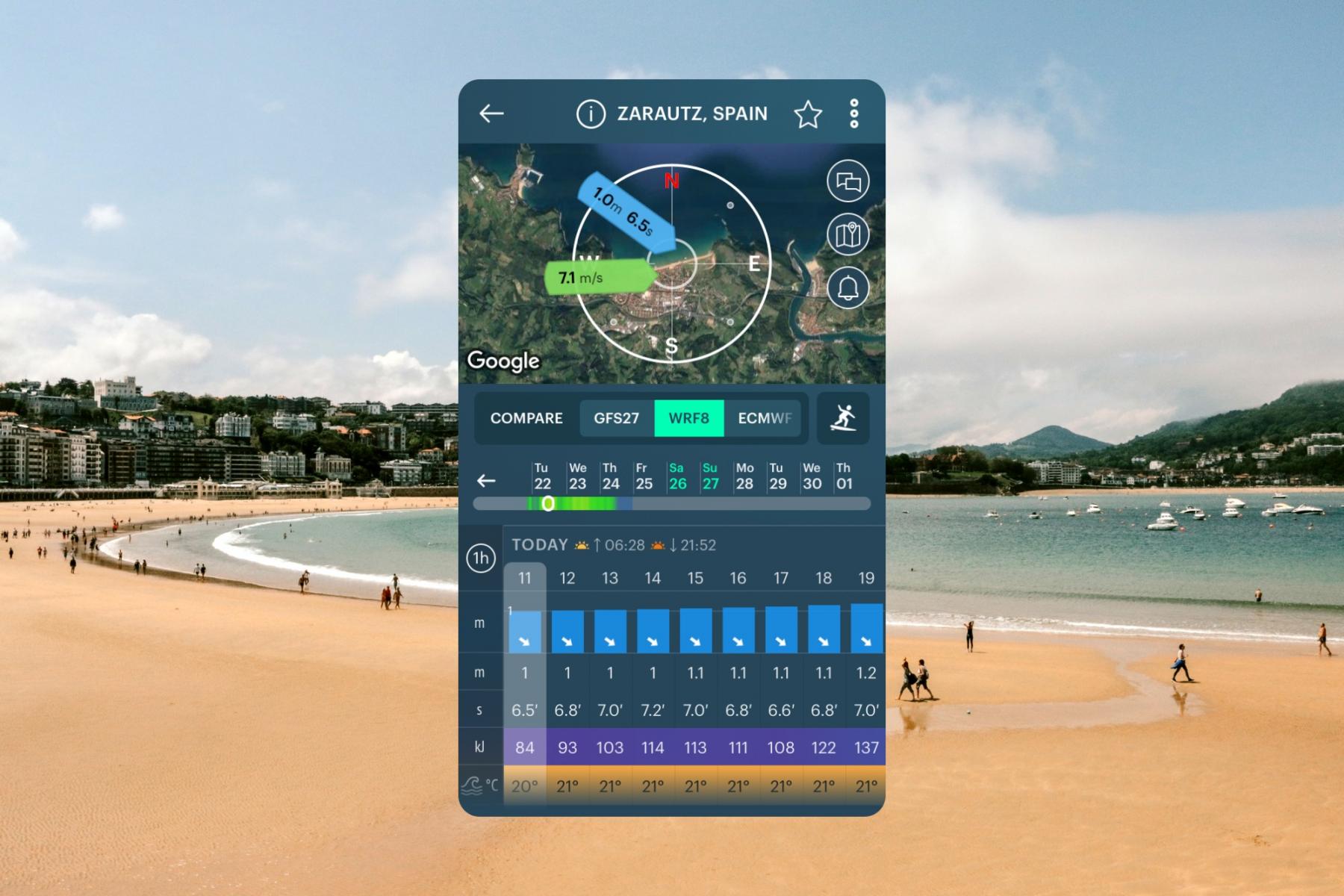
Weather forecast for Zarautz for kitesurfing, windsurfing and surfing in Spain in the Windy.app for iOS
An overview
Zarautz is the surfing capital of the Basque Country, it offers the conditions that every surfer wants to find, good wind and waves. It is an urban beach, its tide is variable most commonly medium, the bottom is sandy and it is a place suitable for surfers of any level of experience. It works best with the wind S. It has both lefts and rights maneuverable. It is an area of a high influx of surfers, especially locals in almost any season of the year. Finally, it has schools all along the beach, it is an ideal destination for beginners, here is detailed information on how to choose a surf school.
The waves depend on the weather conditions but predominantly perpendicular to the coastline, this is due to its location in the open sea. The waves are consistent and start from the west, arriving with equal power to the east.
The main weather features
The weather in Zarautz is classified as warm-temperate, subpolar oceanic with few temperature oscillations. It is characterized by being rainy, 1417 mm annual average. Winters are long, cold, wet, and windy and it is partly cloudy all year round. The temperature in Zarautz starts from 4 °C in February as a minimum of the year and 19 °C as a maximum in August. Humidity is always above 75%.
- Winter. In winter, there are good and high waves, but the temperature rarely rises above 10 degrees and it rains 50% of the time
- Spring. Swells are consistent but not very large and the beaches are completely empty.
- Summer. It is a good season for beginners due to the calm sea, the waves do not exceed one and a half meters.
- Autumn. The sea wakes up after the summer session and brings with it squalls and therefore high waves but rainfall at an average of 49 days
Best time to travel
The best time to visit Zarautz if it’s for surfing will depend on your level of experience and the style you want to practice. It is a windy city but the windiest part of the year goes from October to April with average speeds of 13 km / h the rest of the year on the other hand has an average of 11 km / h. So for beginners, the ideal period would be spring-summer while for intermediate or experts autumn-winter. It is always advisable to take a look at the current regulations for surfers, here you can see them.
Santander
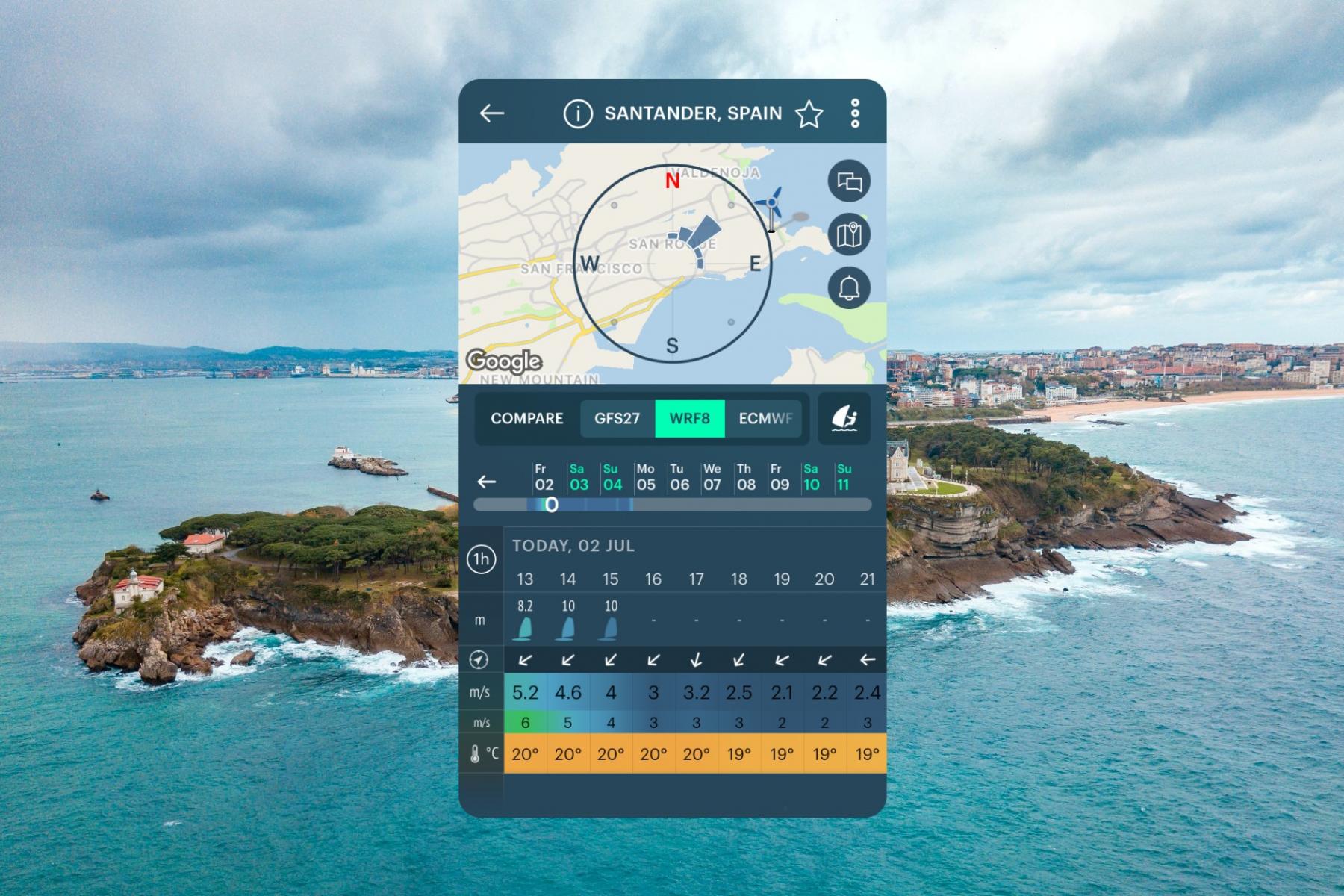
Weather forecast for Santander for kitesurfing, windsurfing and surfing in Spain in the Windy.app for iOS
An overview
Santander is the capital of the region of Cantabria, located on the northern coast of Spain. This has been one of the pioneering areas of surfing in Spain, so it has years of experience in this sport and beaches for all levels. It even has the so-called Natural Surfing Reserve.
For windsurfers, the recommendation is not to miss the beach of Valdearenas.
Somo, Sardinero, Liencres, and Langre are the beaches with the easiest access from Santander, perfect for surfing with waves up to 2 meters during the year.
The main weather features
The weather in Santander is defined as subpolar oceanic with few temperature oscillations, it is characterized by being rainy all year round, even in summer months, it also has abundant rainfall, with an annual average of 1200 mm. Its average humidity is 72%. The wind blows frequently from the ocean and thanks to the breezes from the Cantabrian mountains, sudden temperature increases are possible. Fog is common even on summer nights.
- Winter. The best season for surfing with its northwesterly swells but days of up to 20 °C can occur during the winter.
- Spring. From March to June swells are consistent but not very big and beaches with little affluence — perfect for beginners.
- Summer. The water is warm in summer and it is possible to surf in swimming trunks but beaches with high crowds.
- Autumn. The beginning of autumn being the windiest season of the year with average speeds of over 17 km/h with high and consistent waves.
Best time to travel
The best time to visit Santander for surfers will depend on the level of experience and the style you want to practice. It is a windy area, but the windiest time of the year is from October to April. Thus, for beginners, the ideal period would be spring-summer, while for intermediate or expert level, autumn-winter, when the swells and the diversity of winds create ideal scenarios with sandy bottoms.
For windsurfers, the summer is an ideal season.
Sopelana
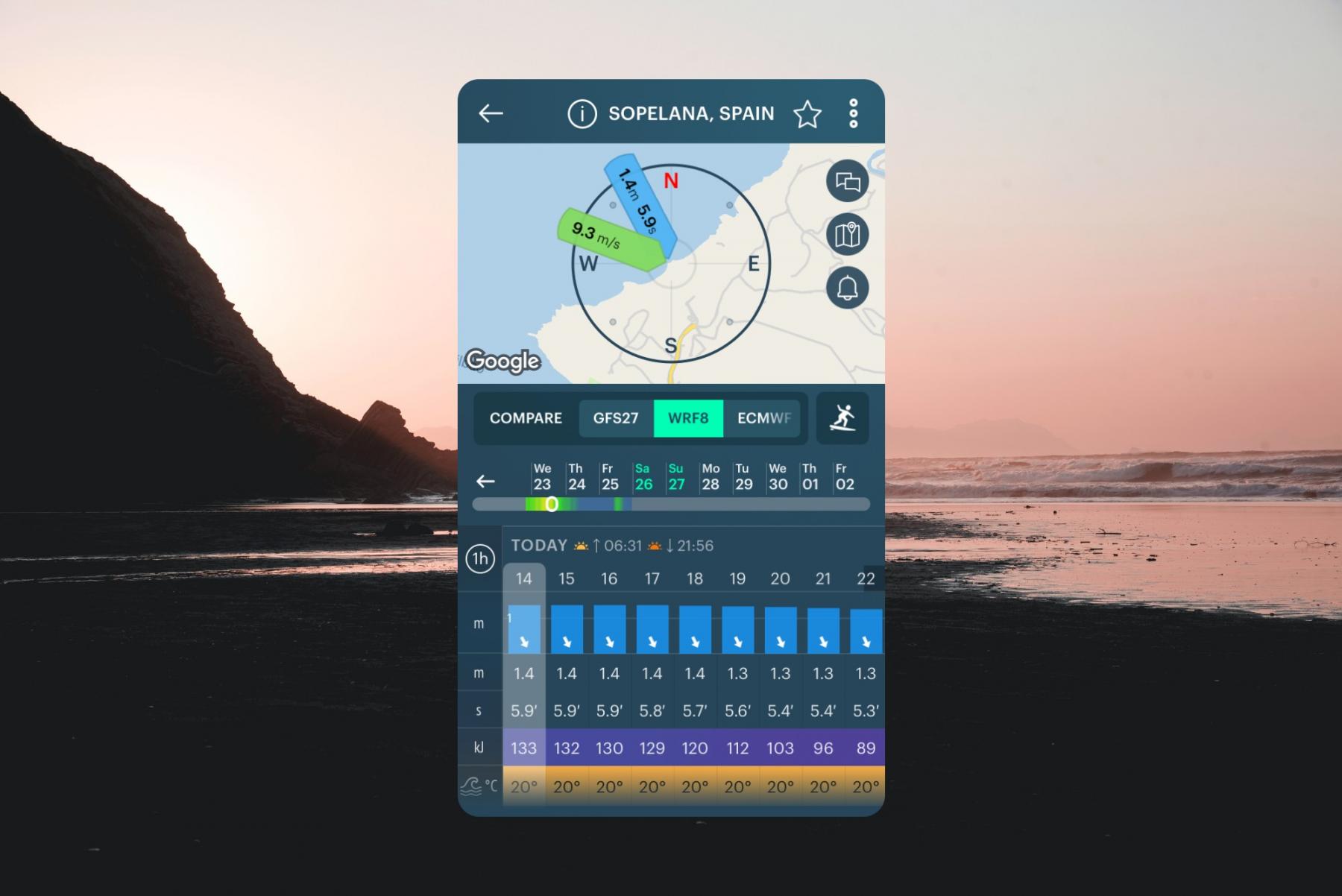
Weather forecast for Sopelana for kitesurfing, windsurfing and surfing in Spain in the Windy.app for iOS
An overview
Sopelana is a municipality in the Province of Vizcaya recognized for its beaches and cliffs, is one of the most recommended destinations for surfing in the Basque Country, offers rocky and sandy bottoms. Winds from the northeast, south, and southeast, swell from the northwest.
It is an area very close to Bilbao and an ideal place to take surfing lessons, but for beginners, it is essential to follow the tide closely because they may encounter very high waves and a little out of control.
Another recommended activity in the area is paragliding.
The main weather features
The weather in Sopelana is classified as warm-temperate, subpolar oceanic with few temperature oscillations. It is characterized by being rainy, 1247 mm annual average. Winters are long, wet, and windy and it is partly cloudy all year round. The temperature in Sopelana starts from 6 °C in January as a minimum of the year and 22 °C as a maximum in the month of August. Its climate is highly determined by the Bay of Biscay. It has a constant humidity always above 75%.
- Winter. In the period from December to March, the waves reach the highest level and it has 52 days of rain in this period.
- Spring. April is the most recommended month in the spring season so fewer crowds, longer days, and more pleasant water temperatures.
- Summer. It is a good season for beginners given the calm sea, the waves do not exceed one and a half meters.
- Autumn. Time undoubtedly only recommended for experienced surfers due to strong winds that reach 21 km/h.
Best time to travel
The best time to visit Sopelana if it is for surfing will depend on the level of experience and the style you want to practice. Thus, for beginners, the ideal period would be spring-summer while for intermediate level or experts autumn-winter.
It is important to keep in mind that water temperatures in Sopelana can drop dramatically during the coldest time of the year so a wetsuit is essential.
For windsurfers, the summer is an ideal season.
Bilbao
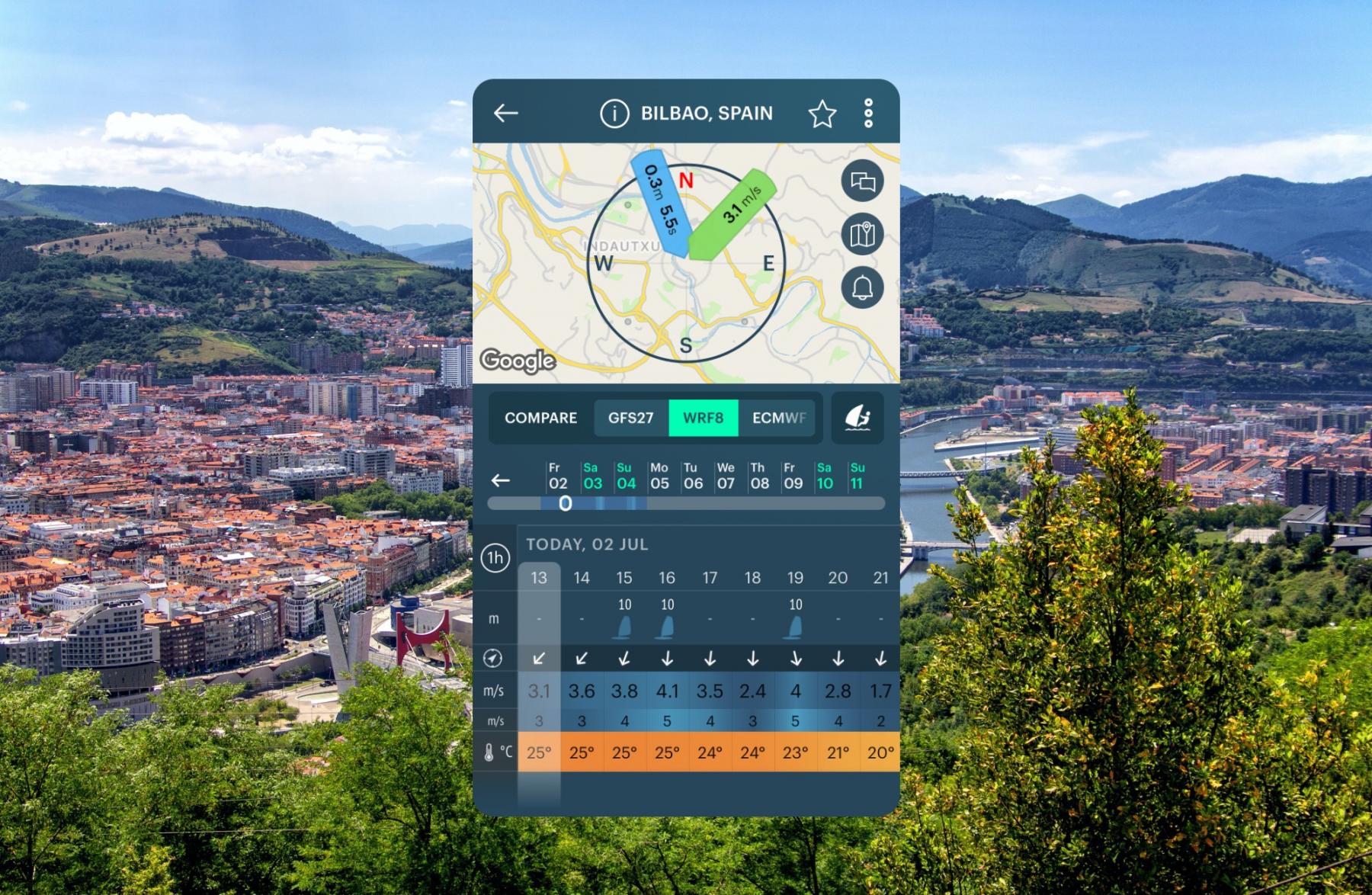
Weather forecast for Bilbao for kitesurfing, windsurfing and surfing in Spain in the Windy.app for iOS
An overview
Bilbao is the capital of the Basque Country, located in the north of Spain. It is known for the wave of Mundaka, a left wave of more than 400 meters long, which has made this destination a favorite of many surfers. It is also the scene of important surfing competitions such as the Basque Surf Circuit and the Basque Country Championship.
There is even a Basque wave route to enjoy this destination by finding the best beaches that are easily accessible from Bilbao. There are beaches for all levels of experience, for inexperienced surfers the beaches of Bakio, Arrigunaga, or Arriatera-Atxabiribil offer the most controlled waves and for expert surfers, there is Sopela and Barinatxe beach.
The weather in Bilbao allows the practice of surfing variants such as bodyboarding, kayak-surfing, and paddle-surfing. Fishing is another common practice in this region, which has numerous fish markets dedicated to it.
The main weather features
The weather in Bilbao is defined as subpolar oceanic with few oscillations of temperature, it is characterized by being rainy all year round, even in summer months, it also has abundant rainfall, with an annual average of 1149 mm. Humidity averages 70%. The wind blows frequently from the ocean and thanks to the valley and mountain breezes, which come from the south, by the Cantabrian mountains, you can have sudden increases in temperature.
- Winter. Winter in Bilbao is the ideal season for experienced surfers with waves reaching their highest level.
- Spring. From March to June stable but not very large waves are ideal for novice surfers.
- Summer. In September, it is quite warm - about 26 degrees - but at the same time 45 rainy days for the entire summer period.
- Autumn. It is the preferred period for surfing, the sea wakes up after the summer session and brings with it squalls and therefore high waves.
Best time to travel
The best time to visit Bilbao for surfers will depend on the level of experience and the style you want to practice. It is a windy area, but the windiest part of the year is from October to April. Thus, for beginners, the ideal period would be spring-summer while for an intermediate or expert level the ideal period would be autumn-winter.
Tarragona
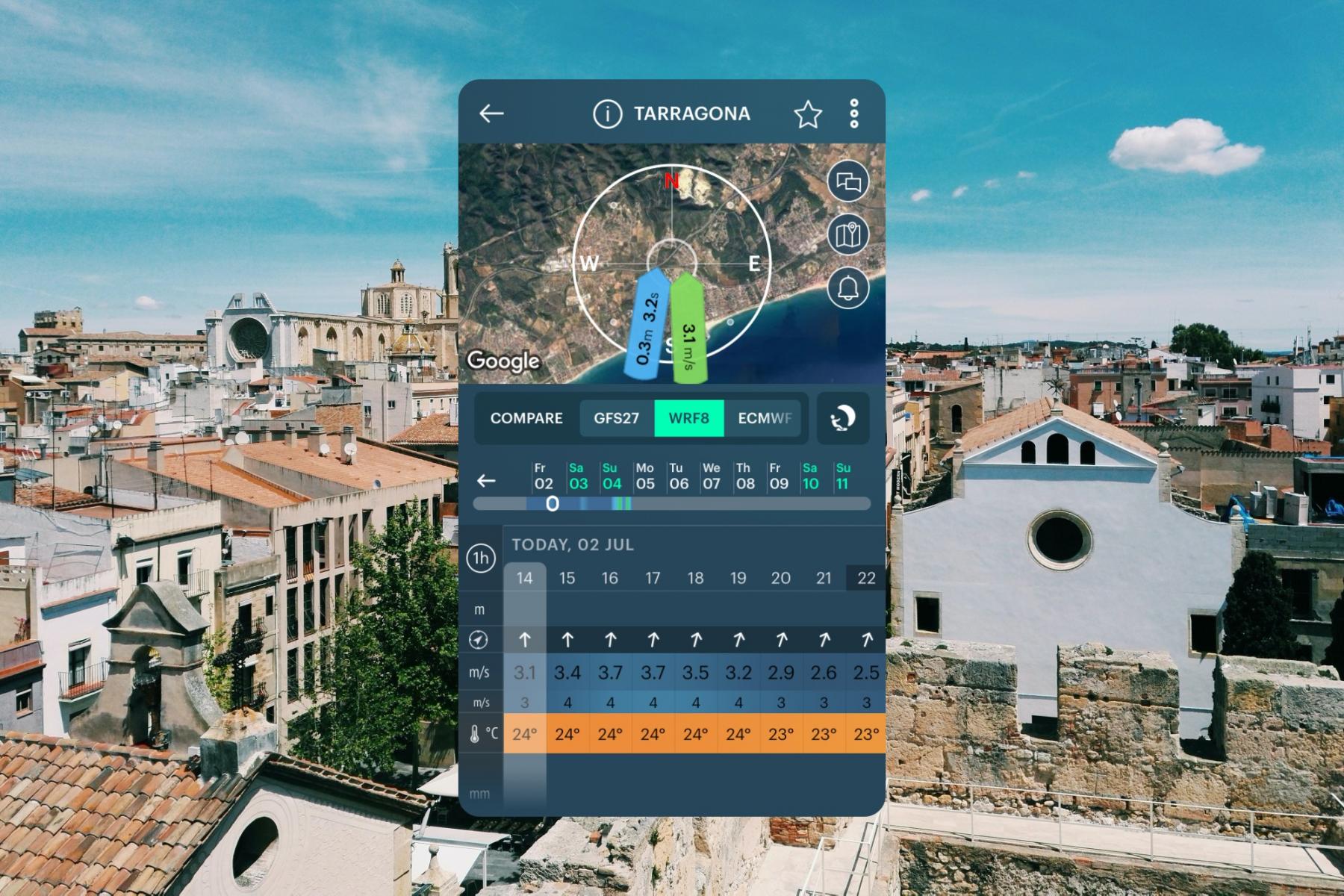
Weather forecast for Tarragona for kitesurfing, windsurfing and surfing in Spain in the Windy.app for iOS
An overview
Tarragona is the capital of its namesake province, located on the Mediterranean coast in the northeast of Spain and south of Barcelona. It is located in the part of the coast called Costa Dorada.
It is important to mention that it is not a water sports destination by tradition and although good conditions can be achieved throughout the year, it requires patience and persistence. It is therefore recommended to keep track of the weather conditions to get the best weather in Tarragona. Here you can find our Guide to weather parameters, data, indexes, icons, and graphs.
The main weather features
The weather in Tarragona is classified as warm and temperate, Mediterranean. In particular, rainfall in winter is rarer than what normally occurs in Mediterranean climates. There are about 50 rainy days a year with a total of 500 mm. It is located 53 meters above sea level and has an average humidity during the year of 70%. The month with the strongest wind and high speed is April (15 km/h) but with gusts that can reach up to (26 km/h).
- Winter. This time there are a small number of swimmers and good waves up to 3 meters.
- Spring. Tarragona has long sandy beaches open to the sea, which will provide not very aggressive and medium-length waves at this time of year.
- Summer. In the period from June to September, there are very small waves and the beaches are very busy.
- Autumn. The best waves are during this period but it is too rainy and the water temperature can drop to 12 degrees.
Best time to travel
The best time to visit Tarragona for surfers is between September and March, this is the time when the best waves are found. From spring and during the summer it is almost impossible to find days with a good tide. For windsurfers, the summer and spring are good seasons with flat water.
Tenerife
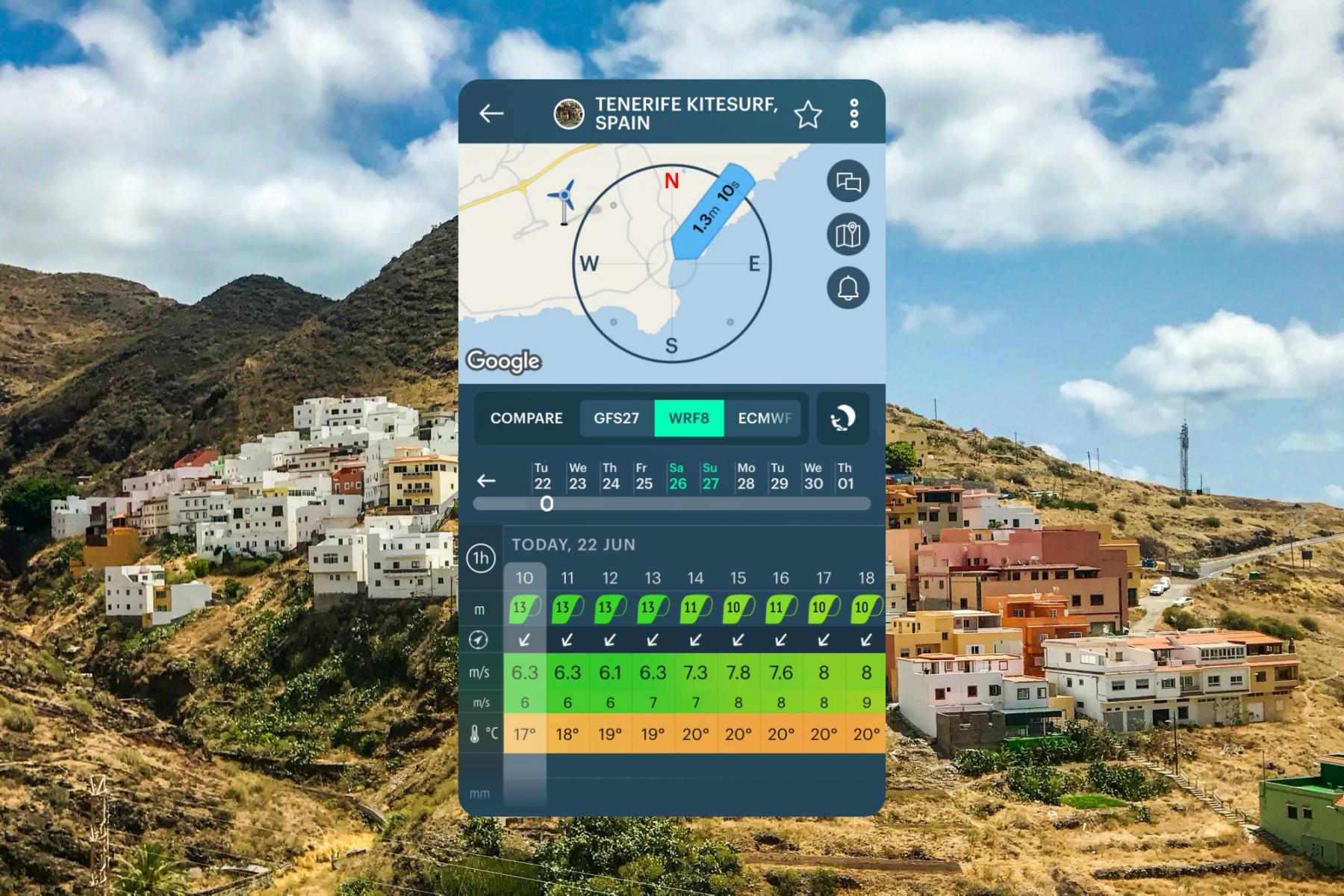
Weather forecast for Tenerife for kitesurfing, windsurfing and surfing in Spain in the Windy.app for iOS
An overview
The island of Tenerife is the largest of the seven Canary Islands and is located in the Atlantic Ocean and belongs to the Spanish autonomous community of the Canary Islands. It is centrally located between the islands of Gran Canaria and La Gomera.
In Tenerife, the waves break on all types of bottom from rocks, sand to the volcanic reef, so it can meet the needs of all levels of expertise.
Another option is the practice of hiking and extreme sports — Teide National Park.
The main weather features
The weather in Tenerife is characterized by mild temperature conditions in the summer and warm for the winter, the presence of the sun is constant throughout the year. The temperature ranges between 17 °C and 25 °C. The presence of the sea breeze and the trade winds make it an ideal destination for surfing and all wind sports. More information on how the sea breeze influences the weather can be found here. There are about 40 rainy days a year.
The weather in Tenerife is divided between the north, which is much windier and wetter, and the south, which is warmer and drier. It is so extreme that you can even find snow on the Teide volcano and at the same time a day at the beach in another part of the island.
- Winter. It is not a good period for beginners, especially when the waves break against the reefs, perfect for more experienced surfers.
- Spring. It is the right time for beginner surfers or those looking for gentle waves and fewer people.
- Summer. There are still possibilities for surfing but it is best to get advice from local experts to know the areas that work best in general terms.
- Autumn. Autumn brings with it the best waves of the year and swells at their maximum expression with west-northwest direction.
Best time to travel
The best time to visit Tenerife for the most skilled surfers will be the autumn-winter season where they will find the most extreme swells and tides thanks to the low Atlantic pressures.
Beginners can use the calm of spring to their advantage, it is also an ideal season to take courses since it is not high season.
In short, summer is the least recommended season, since even if you can find phenomenal days for surfers, it is difficult to have an accurate forecast.
However, the island presents opposite conditions, in some occasions, between the north and the south, a situation that favors the practice of surfing all year round, it is enough to have the knowledge of all the available spots and the best conditions according to the season.
Cadiz
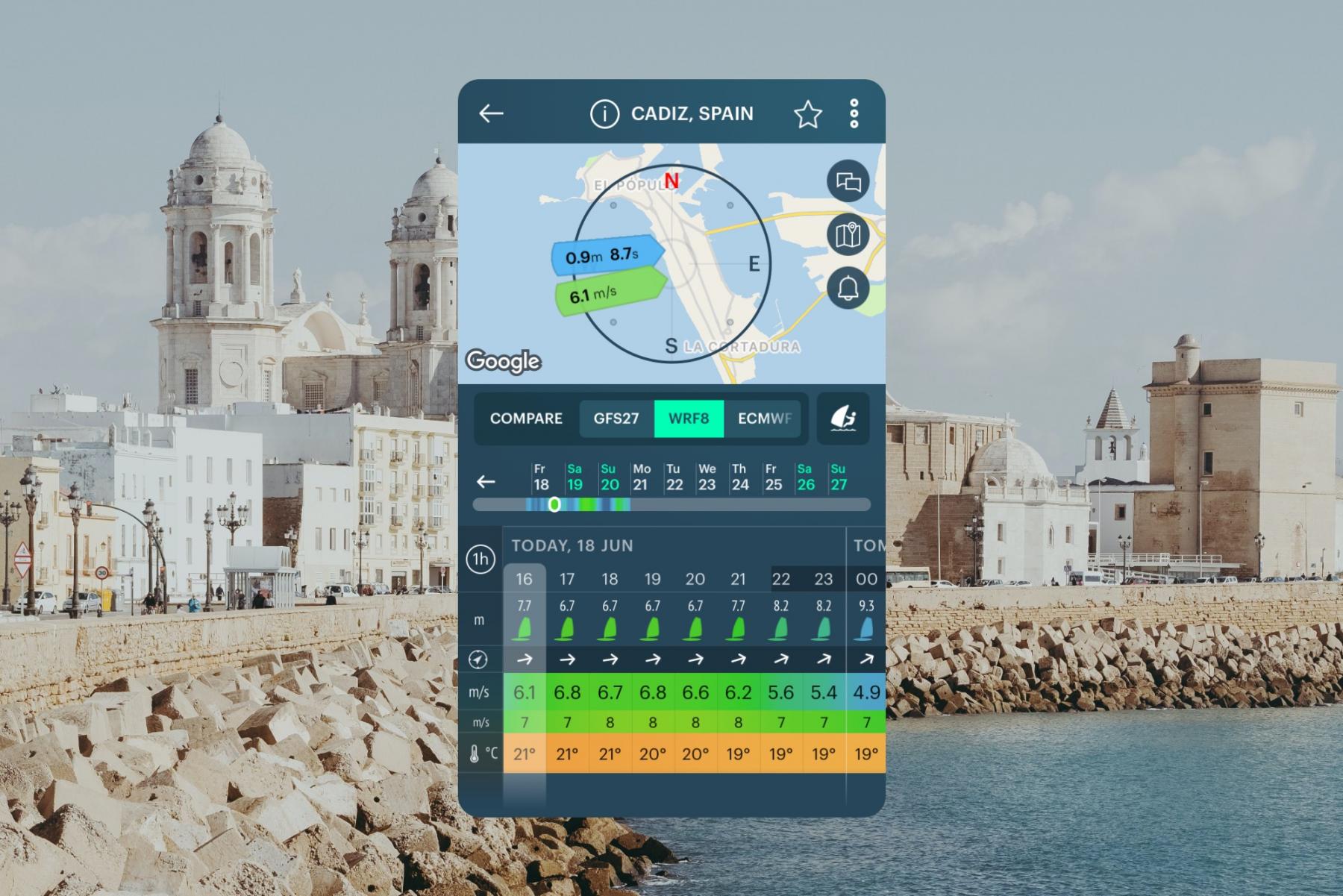
Weather forecast for Cadiz for kitesurfing, windsurfing and surfing in Spain in the Windy.app for iOS
An overview
The coast of Cadiz is ideal for all types of water sports throughout the year, which is why this area enjoys great popularity among professionals and amateurs. It offers a wide variety of complementary services such as schools, equipment rentals, and accessory stores.
The beaches of Cadiz have gentle waves, sandy bottoms and usually do not present strong currents, making it an ideal place for beginners at any time of the year. It is possible to enjoy the Atlantic with the practice of surfing, kite surfing, sailing, scuba diving, diving among the most prominent. Los Caños de Meca is famous for its crystal clear waters and white beaches.
The rest of the province offers activities such as hiking in the different natural parks or combine with the risk and adventure of canyoning, mountaineering, or paragliding.
The main weather features
The weather in Cadiz can be classified as warm Mediterranean subtropical. It is characterized by mild temperature conditions without major seasonality, dry summers, and rainy and changeable winters due to the polar front, with November being the month of highest rainfall, while July is the warmest and driest month. It has an average humidity of 72%, with little variation during the year.
- Winter. March and December are the windiest months with wind speeds of more than 30 km/h. In this period of the year, the westerly wind is the most common, hitting the Sierra causing heavy rains.
- Spring. It is the beginning of the season of easterly winds, the period in which these are strong so we recommend kites or sails of medium or small size to avoid breakage or complication in the control of the artifacts given its intensity.
- Summer. Summer in Cadiz is long and hot due to the high humidity that increases the thermal sensation but there are restrictions due to the high influx of people on the beaches, so it is not an ideal time for surfing.
- Autumn. Given the low influx of bathers, it is an ideal season for surfing and there are even fewer restrictions and therefore more options for beaches and some salty rivers.
Best time time to travel
The best time to visit Cadiz depends on the sport, the level of expertise, and the athlete’s goal. Any time of the year is suitable as it has excellent weather conditions of wind and sun.
To determine the most appropriate season it is convenient to establish whether you are looking for an easterly or westerly wind. The easterly wind is between May and October and is perfect for windsurfing and kitesurfing experts who want to perform tricks and have powerful equipment. On the other hand, the Poniente, which would be the season between November and April, is ideal for clear and clean skies, bright sunshine, and fresh but less powerful wind.
For surfers, winter is undoubtedly the best season since it is when you get the best waves.
Lanzarote
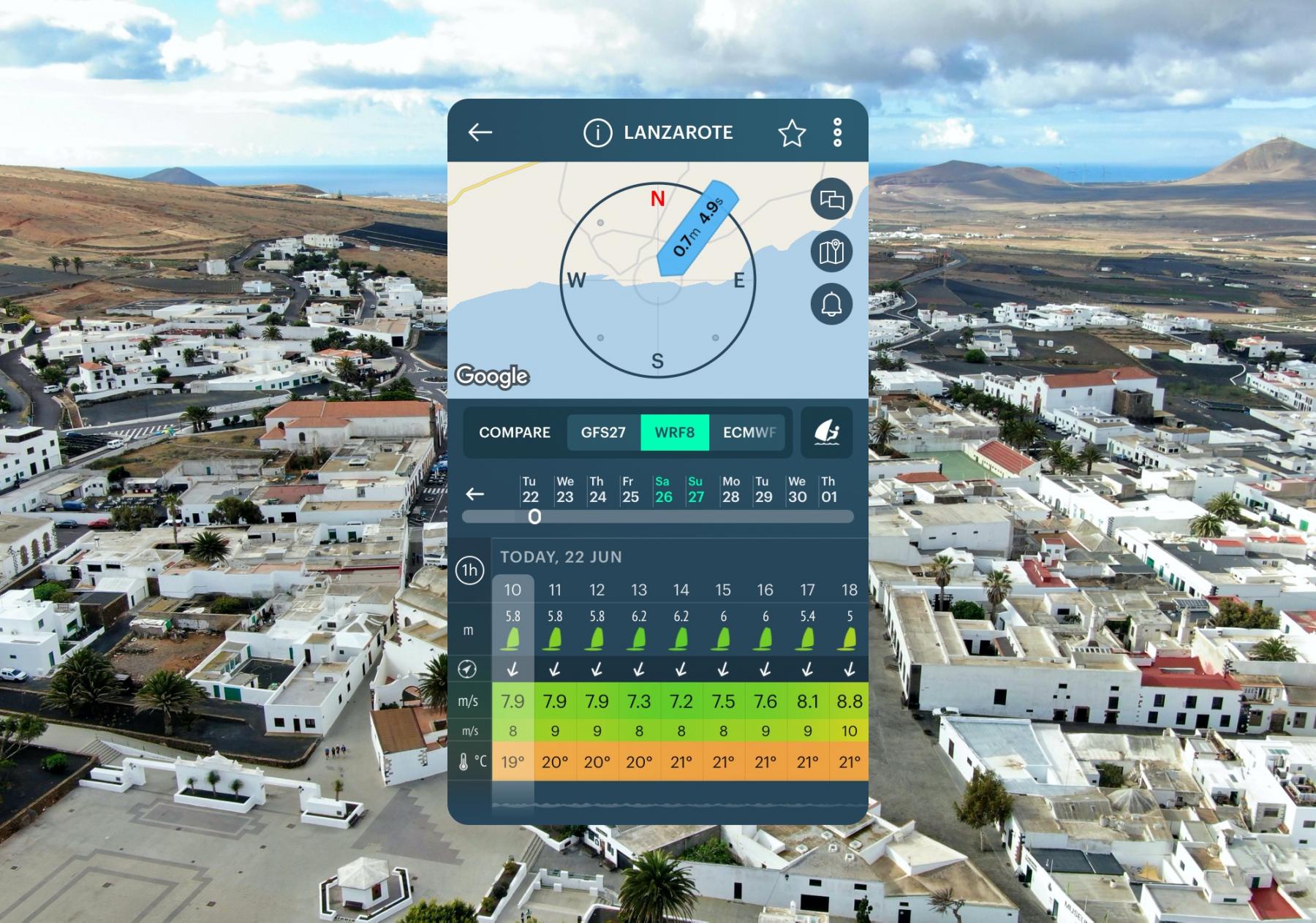
Weather forecast for Lanzarote for kitesurfing, windsurfing and surfing in Spain in the Windy.app for iOS
An overview
Lanzarote is part of the Canary Islands, off the coast of West Africa, and located in the province of Las Palmas in Spain. It is the ideal destination for kitesurfing and windsurfing lovers, with excellent wind conditions during a good period of the year.
Famara beach is a favorite for kitesurfing because it has ideal wind conditions and because it has several peaks in the deepest areas that allow kitesurfers to make pirouettes in the air and execute their movements with ease.
Windsurfers, on the other hand, have two central areas. For beginners Las Cucharas and for the more experienced Jameos del Agua, a place located in the north of the island that allows lefts especially when the trade winds are present.
The main weather features
The weather in Lanzarote is characterized by mild winters and hot and sunny summers. It is a subtropical climate with constant sunshine and low rainfall, which generally does not exceed 150 mm per year. It has wind currents such as the northeast trade winds during the summer and is also influenced by its proximity to the Sahara Desert and the land breeze, constant and strong wind that comes from the earth with great propulsion.
Temperatures range from 14 °C to 29 °C. The weather in Lanzarote is determined by two microclimates, the northern one which is much windier and more humid, and the southern one which is warmer and drier.
- Winter. It is possible to find windy days during the winter, although less strong than in the summer, to surfing, but given the water temperature of 17°C on average, the use of neoprene is recommended.
- Spring. It is an ideal season for beginners that wind that blows more consistently and of higher quality than in other seasons of the year and there are few tourists.
- Summer. It is a dry season, with the possibility of zero rainfall, and only in September may begin to rain but in low proportions.
- Autumn. There are too few windy days during this period, so it's worth choosing other places for skiing
Best time to travel
The best time of year to visit Lanzarote, for the purpose of kitesurfing and windsurfing, is undoubtedly summer, especially June and July when the trade winds reach their peak. However, months like April in the spring and December in the winter are still interesting options especially to avoid the high influx of bathers during the summer.
Autumn is definitely not the best time to visit Lanzarote, with almost no wind it is not the ideal season for kitesurfers or windsurfers.
Murcia
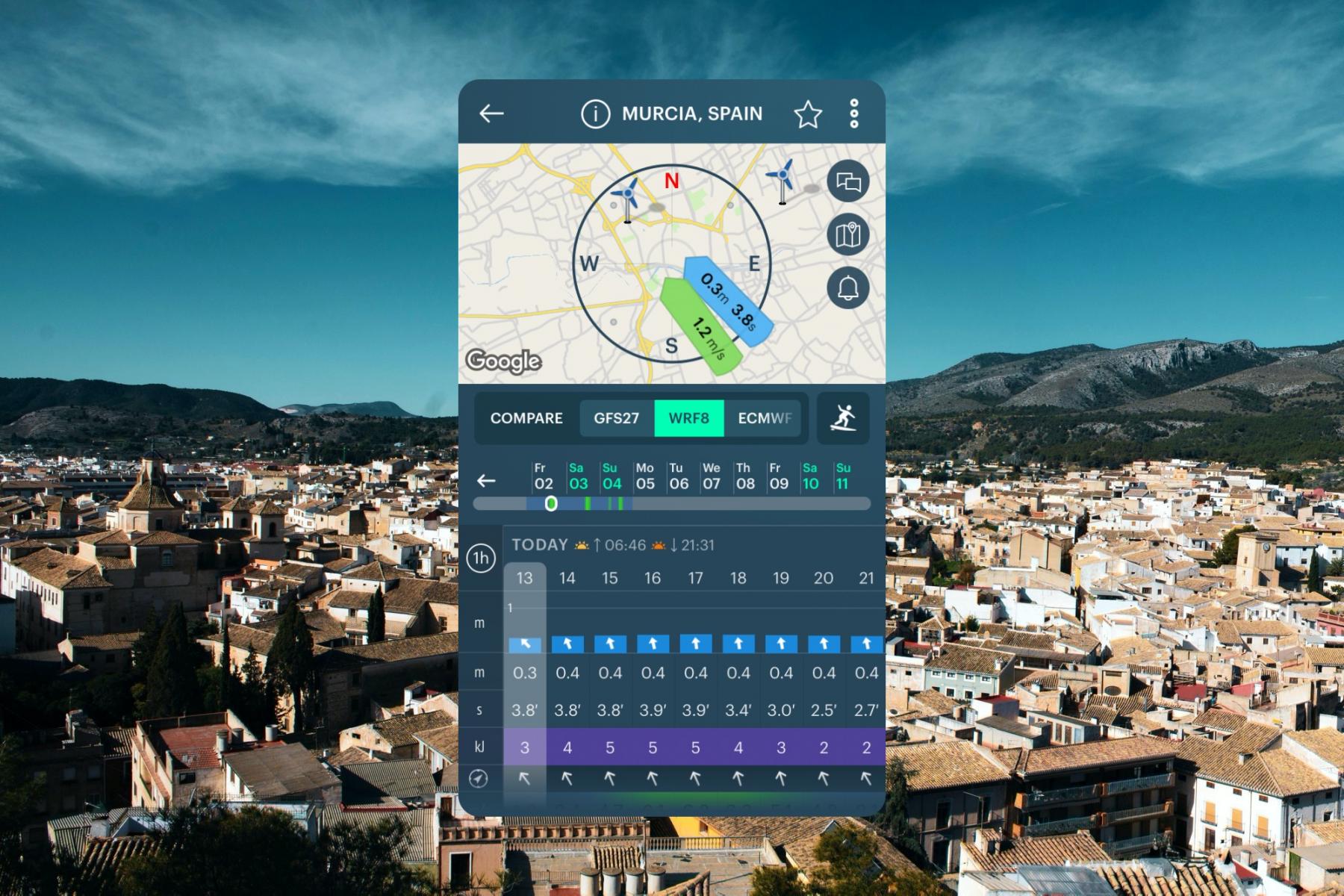
Weather forecast for Murcia for kitesurfing, windsurfing and surfing in Spain in the Windy.app for iOS
An overview
Murcia, also known as Costa Cálida, is the capital of its namesake province, is located on the southeastern coast of Spain, 40 km from the Mediterranean. It is not a traditional surfing destination, it is relatively new, it does not have waves of much consistency but winter brings some possibilities. It is creating a scenario more than anything at the training level, with schools but also taking surfing to even academic and university levels. It is known for its women’s surf league.
Murcia is a destination with possibilities for windsurfing and kitesurfing, highlighting also.
The beauty of its natural areas turns the practice of water sports into a contemplative exercise, an experience to enjoy reserves and scenarios with high levels of conservation.
Additionally, given the number of natural reserves, alternatives such as mountain biking and hiking can be an interesting complement.
The main weather features
The weather in Murcia is practically Mediterranean, as it has pronounced acidity, hot summers, and mild winters. It has only some torrential rainfall during the year, about 65 days of rain per year (312 mm). The month with the highest winds in February with 12 km/h, October is the calmest with an average speed of 7 km/h.
- Winter. Between the end of December and the end of March the most frequent winds are from the east and northeast. We recommended La Plana Beach in this time.
- Spring. Although it is difficult to find consistent waves during this period, there can still be good surfing sessions, especially during the first part of spring
- Summer. The biggest influx of tourists is at this time, so you need to check the restrictions on visiting beaches.
- Autumn. There are very few people on the beaches, and the waves are up to 1.5 m, so it's a good time to surf.
Best time to travel
The best time to visit Murcia for surfers without a doubt is autumn-winter where they will find the most demanding waves. While between spring and summer windsurfing and kitesurfing are the protagonists.
In any case with 300 days of sunshine and an average annual temperature of 19 °C Murcia is an ideal place for water sports and is consolidated as an ideal setting for beginners with a large number of schools offering lessons throughout the year.
Motril
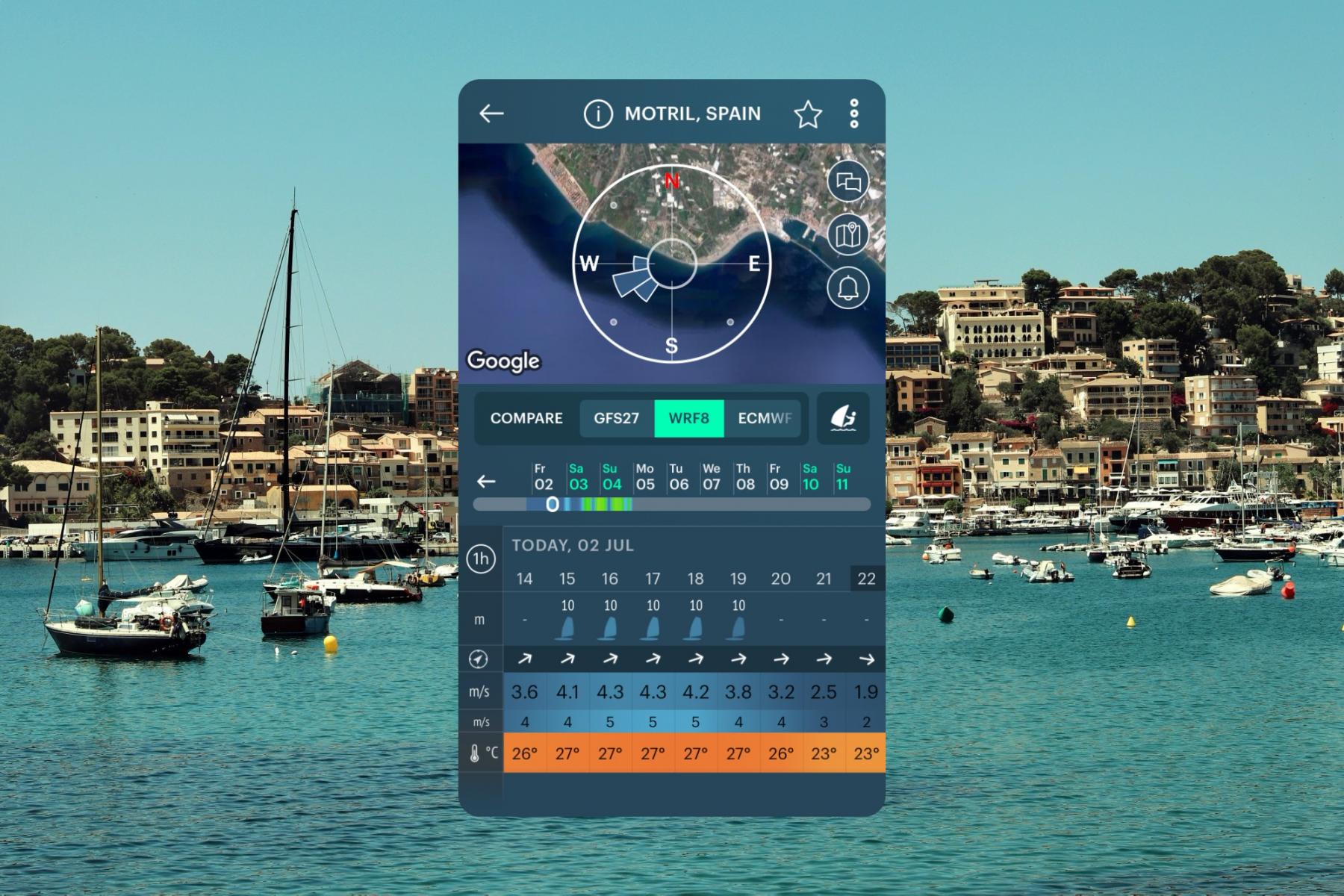
Weather forecast for Motril for for kitesurfing, windsurfing and surfing in Spain in the Windy.app for iOS
An overview
Motril is located on the shores of the Mediterranean, in the central part of the Costa Granadina, in the autonomous community of Andalusia in Spain. It has an important windsurfing tradition and many schools. It is interesting the possibility of doing wind sports not only on the coast but also in the nearby reservoirs, finding more controllable conditions and sometimes more favorable than those of the sea.
It also has ideal scenarios for both surfing and kitesurfing, with different characteristics and levels of demand.
The main weather features
The weather in Motril is the Mediterranean, with mild and relatively rainy winters and hot and sunny summers. The wind blows frequently and in the cold half of the year is accompanied by rain and showers, while in summer it blows as an afternoon breeze. The highest mountain range of the Iberian Peninsula is located near this city, generating effects in its climatology.
- Winter. The weather in Motril during the winter can be very variable, days with light and moderate winds and others with large waves of more than three meters and winds of more than 60 kilometers per hour on the coast, which is an ideal scenario for experienced surfers.
- Spring. From spring onwards, thermal winds from the southeast begin to blow with average temperatures of 23 °C.
- Summer. The temperatures of both the environment and the water reach the maximum but there are restrictions due to the high influx of people on the beaches.
- Autumn. it is possible to surf there at any time of the year, the waves are highest in autumn.
Best time to travel
The best months for windsurfing and kitesurfing in Motril are from May to November. The time of highest rainfall is during the winter so it is not the most ideal time for water and wind sports but it is the perfect time for surfing since it reaches the maximum swell.
To decide the right time to visit Motril we recommend you to know how the wind rose works, it can be very useful to know the weather conditions of the area.
Palma de Mallorca
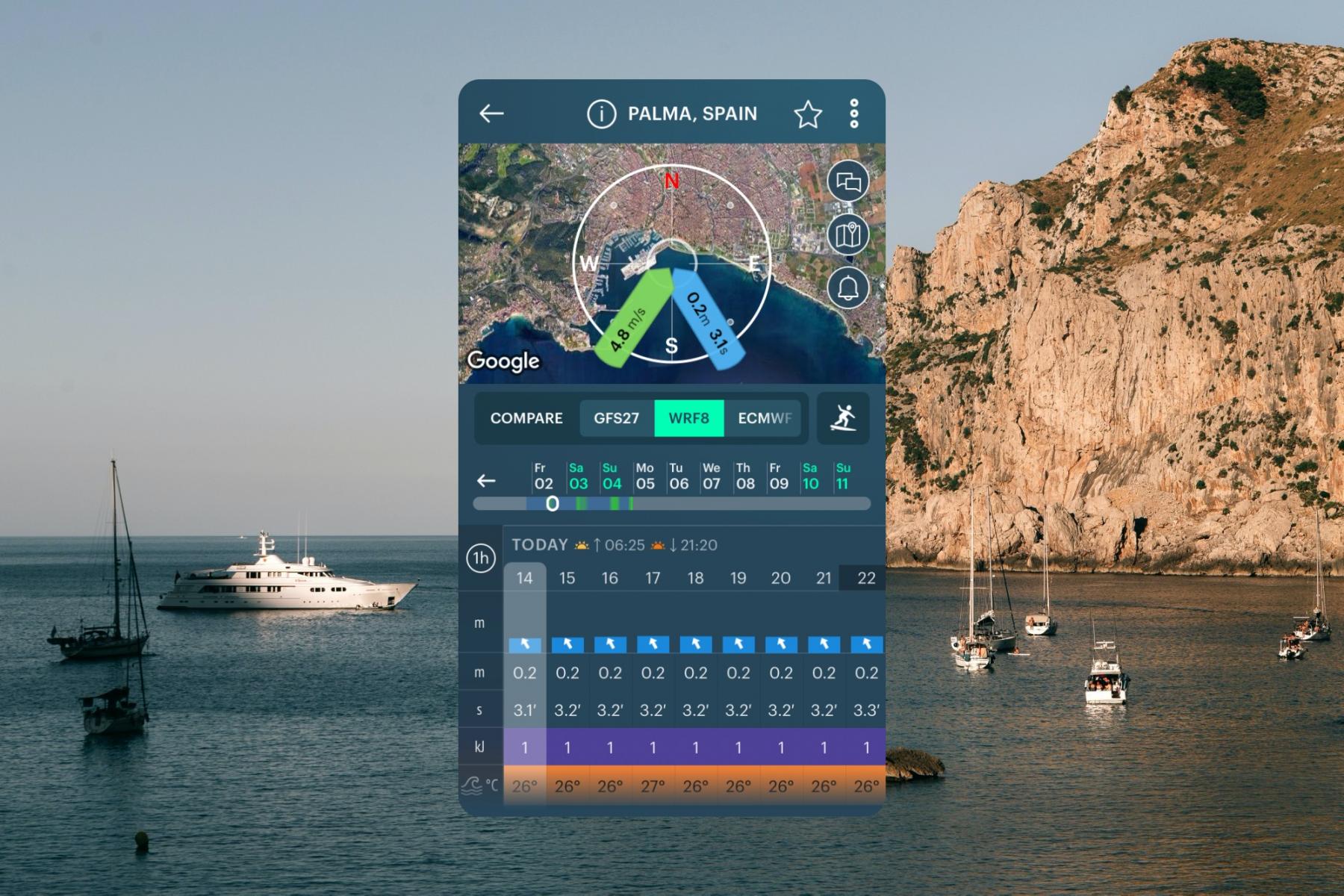
Weather forecast for Palma for kitesurfing, windsurfing and surfing in Spain in the Windy.app for iOS
An overview
Palma de Mallorca is the capital of the Balearic Islands and is located on the island of Mallorca. It is located in the southwest of Europe. It has the Bay of Palma, one of the best places for windsurfing and surfing in the south of the island.
It is known for water sports, among which stand out, in addition to windsurfing and kitesurfing, kayaking, paddle surfing, and swimming. An interesting alternative to these sports is cycling, which has gained momentum in recent years with coastal and maritime rides.
The main weather features
The weather in Palma is classified as the Mediterranean with mild winters and hot and sunny summers, with a constant breeze. Rainfall is not abundant, on average 55 days a year, and is more frequent in the cold half of the year, in contrast, the summer is dry with a low probability of rain.
- Winter. It is a period of wind and rain. The maximum temperature is around 15 °C and the minimum is 5 °C with 16 days of rain during the season.
- Spring. April is the not ideal season for surfers, given the local thermal wind or sea breeze that develops over land and has a variable intensity of 15 knots.
- Summer. The weather during June and July presents wind in 99% of the days. It is an not ideal season for surfing. High probability of thermal winds.
- Autumn. Very unreliable weather for surfing lessons due to the weather conditions. Therefore not recommended for beginners.
Best time to travel
The best period to visit Palma for kitesurfers is spring without a doubt since there are no restrictions in the different areas of the island for the practice of this sport. It is also the period with the best weather conditions.
On the other hand, for windsurfers, the best season is June and July, where the thermal wind is guaranteed.
Cartagena
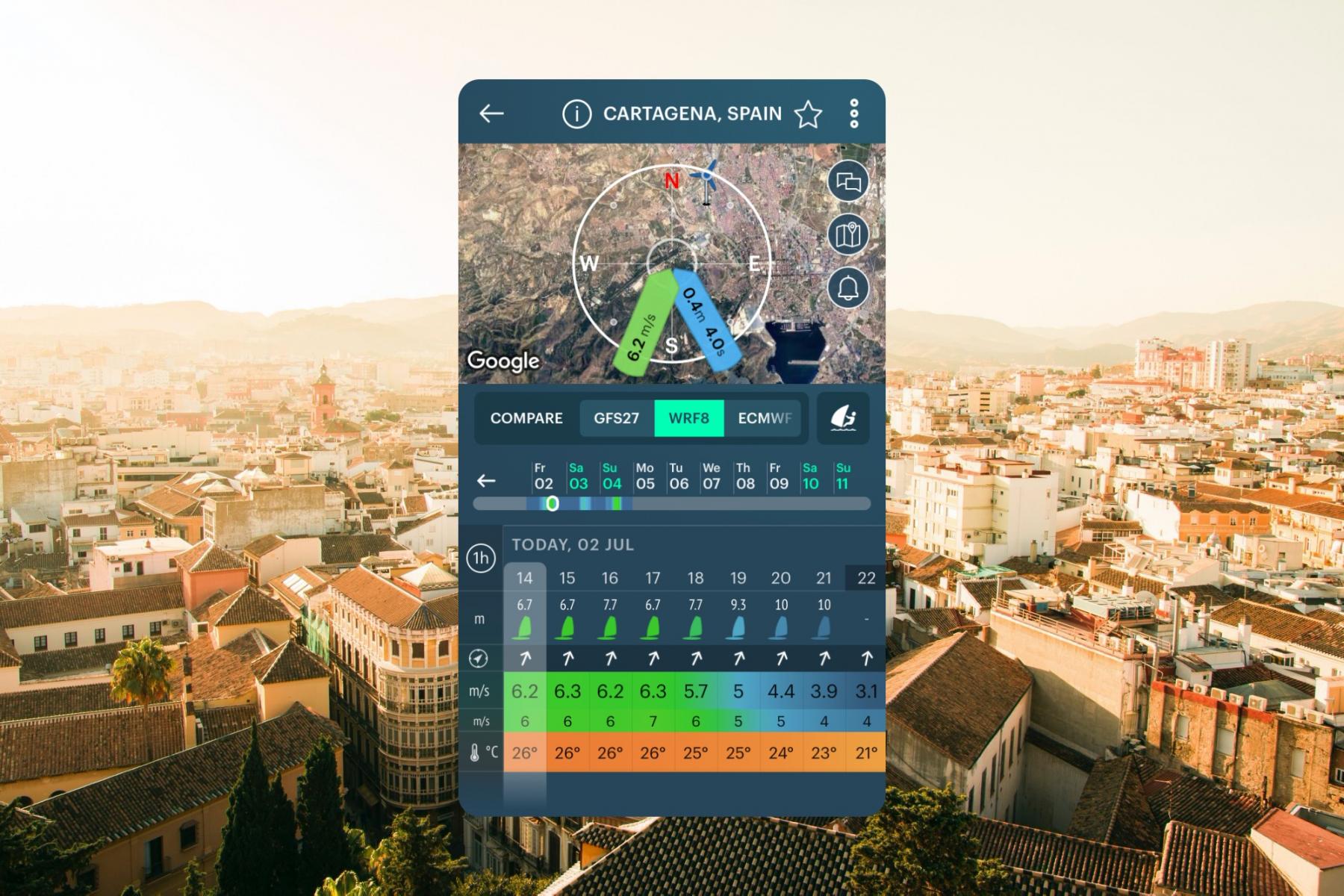
Weather forecast for Cartagena for kitesurfing, windsurfing and surfing in Spain in the Windy.app for iOS
An overview
Cartagena is a port city located on a wide bay, capital of the autonomous community of Murcia, and situated on the Mediterranean coast, in the area known as Costa Cálida, in Spain. It is located on five small hills and therefore offers hiking options in addition to the maritime offer.
The main weather features
The weather in Cartagena is the Mediterranean, with mild winters and little rain and hot and sunny summers. It is located 19 meters above sea level. It has only some rainfall during the year, about 31 days of rain per year and a total of 272 mm. To become an expert in meteorology follow the textbook.
- Winter. The most frequent winds during this season are from the east and northeast so waves can reach up to 2 m.
- Spring. The weather in Cartagena during this period brings winds from the southwest.
- Summer. Thermal winds from the southeast result in a sea with little swell.
- Autumn. The most recommended beach during this period is Playa Paraiso with northeast and northeast winds, suitable for an intermediate level of experience.
Best time to travel
The best time to visit Cartagena for surfers without a doubt is autumn-winter where they will find the most demanding waves. While between spring and summer windsurfing and kitesurfing enter the scene. However, the restrictions of the summer make it not a favorite period or at least a phase in which you should plan in a more detailed way the activity to be performed.
Castelldefels
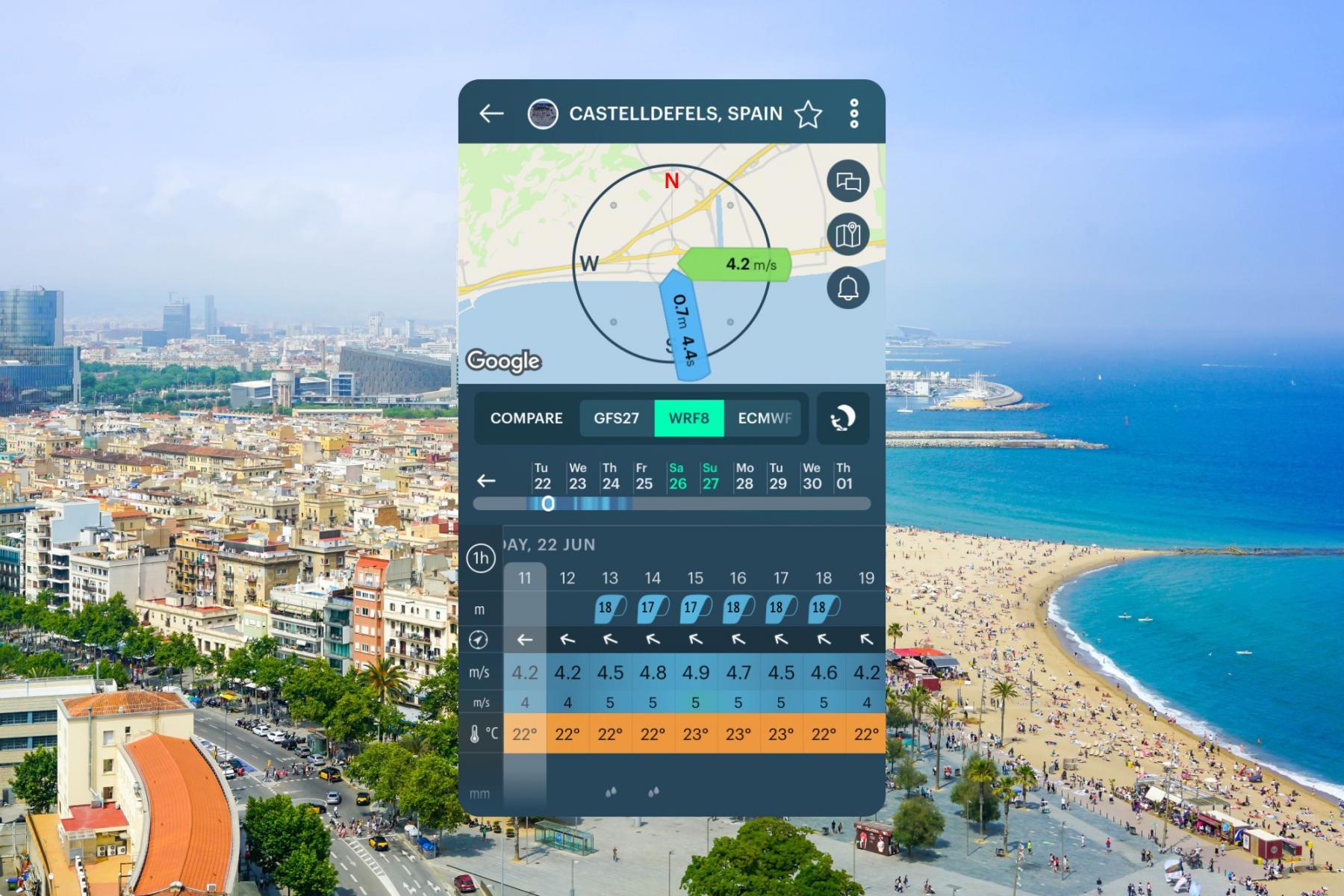
Weather forecast for Castelldefels for kitesurfing, windsurfing and surfing in Spain in the Windy.app for iOS
An overview
Castelldefels has more than 5 km of beach, known for surfing and kitesurfing and for its proximity to Barcelona. It is cataloged as one of the best options in Catalonia for the practice of these sports. It has accurate weather forecasts so planning is easy. Port Ginesta, 3 km from Castelldefels, is a marina with a sandy bottom, famous for its long and powerful waves that are born in a rock breakwater. They are straight and work with all tides and with SE and E swells.
The main weather features
The weather in Castelldefels is classified as warm temperate, typical Mediterranean. It is characterized by mild temperature conditions with no major seasonality. There are about 143 rainy days a year, mostly during the autumn-winter period, with July being the driest month, but with constant rainfall. It is located 35 meters above sea level and has a relatively constant humidity always above 74%. The month with the strongest and highest wind speed is January (16 km/h) and the calmest and lowest wind speed is July (10 km/h).
- Winter. The temperature of the water reaches its minimum so that the neoprene becomes indispensable.
- Spring. The Garbí wind predominates, blowing across the shore from the right, and is reinforced by the sea breeze so there are goodl small waves.
- Summer. Unattractive weather for experienced surfers given the calm wind but still an good option for beginners.
- Autumn. It is the rainiest period of the year with 272 mm and 40 days of precipitation in the total season with temperatures dropping progressively from 23 °C to 7 °C as a minimum.
Best time to travel
The best time to visit Castelldefels if surfing is your thing will always be autumn-winter. You’ll find the highest waves and the most suitable wind. However it is a year-round surfing destination, if you are less experienced spring is a good idea.
If you come for kitesurfing instead it is important not to do it during the summer because of all the restrictions for the practice of this sport. Spring with its Garbi winds is the ideal season.
Castelldefels weather forecast
Marbella
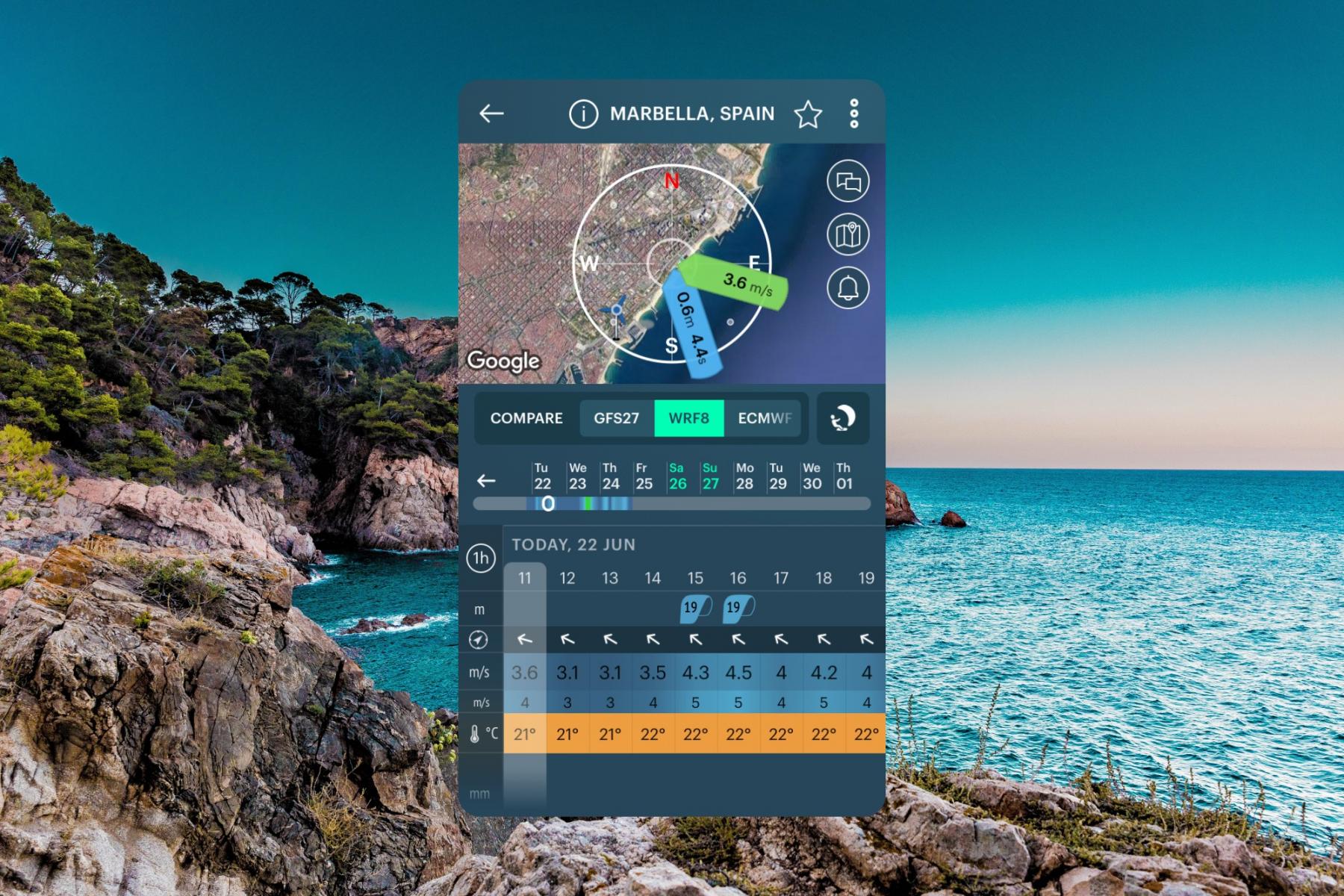
Weather forecast for Marbella for kitesurfing, windsurfing and surfing in Spain in the Windy.app for iOS
An overview
Marbella is a large and popular seaside town on the southern coast of Spain, between Gibraltar and Malaga.
Marbella is a destination known for its benevolent climate with few days of rain per year, at least 300 days of sunshine, and with certain particularities given its geographical position in which the surrounding mountains and the inlet configuration of the coast serve as a blockade of the north winds which produces a unique microclimate.
It has several beaches where surfing and kitesurfing are protagonists:
- Playa del Pinillo is one of them, there are good waves for surfers as they are not loaded with force is an ideal place for any level of experience.
- For its part, Cabopino is ideal for kitesurfers. The latter requires prevention since it is delimited with rock breakwaters, which can be dangerous for kitesurfing, especially when there is a westerly wind.
- For the most skilled in kitesurfing, Playa Rio Real is the ideal place, has pronounced rock formations so it is a place reserved for experts of the board.
- Playa Guadalmansa is characterized for being one of the beaches with the highest number of windy days per year and has the largest number of schools.
The main weather features
The weather in Marbella is characterized by mild and regular temperature conditions throughout the year, it is a Mediterranean climate, hot, humid, and arid summers and long, cool, windy, and partly cloudy winters. The temperature has a maximum of 29 °C in August and a minimum of 8 °C in January. About 668 mm of precipitation per year, mostly during the autumn-winter period, with July being the driest month. It is located 60 meters above sea level and humidity varies between 60% and 74%.
- Winter. February is the windiest month of the year, reaching up to 18 km/h so there is no congestion of travelers
- Spring. Spring is characterized by warm days and cool nights and from April onwards it is possible to swim at the beaches.
- Summer. August is the least windy month of the year with an average speed of 13 km/h but the water temperature reaches the warmest of the year
- Autumn. As in winter, the season with the lowest concentration of travelers, a good choice for those who prefer to have beaches and wind only for themselves.
Best time to travel
The best months to kitesurf in Marbella depend on your level of expertise and what your goal is. Any time of the year is suitable because it has excellent weather conditions of wind and sun. To determine the most appropriate season it is convenient to establish whether you are looking for strong or light winds, given the large number of beaches dedicated to kitesurfing in Marbella it is possible to practice all year round without major restrictions.
Learn more about how to read the surf / swell forecast in a special Windy.app presentation with examples and tips from professional surfers with many years of experience of riding the biggest and best waves on the planet.
Text: Diana Marcela Zuluaga. Ivan Kuznetsov and Masha Shapovalova contributed to this guide
Cover photo: Costas Antwnakakis / Pexels
You will also find useful
Latest News
Professional Weather App
Get a detailed online 10 day weather forecast, live worldwide wind map and local weather reports from the most accurate weather models.
Compare spot conditions, ask locals in the app chat, discover meteo lessons, and share your experience in our Windy.app Community.
Be sure with Windy.app.



